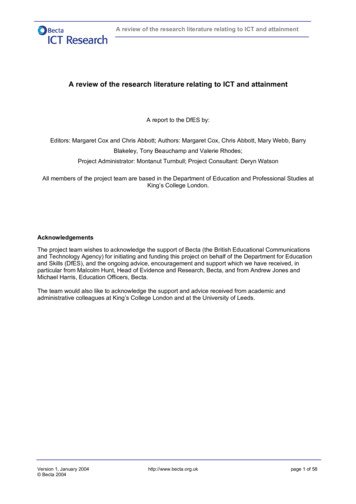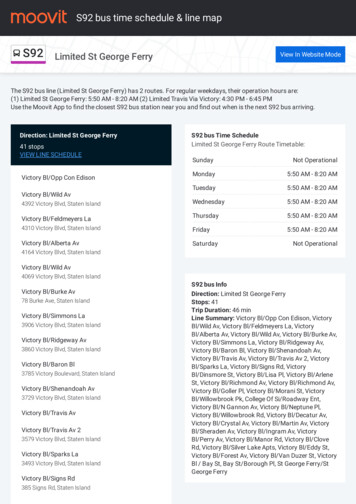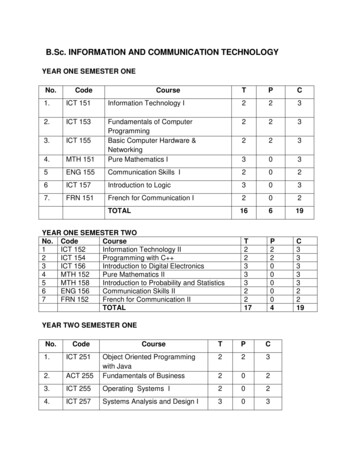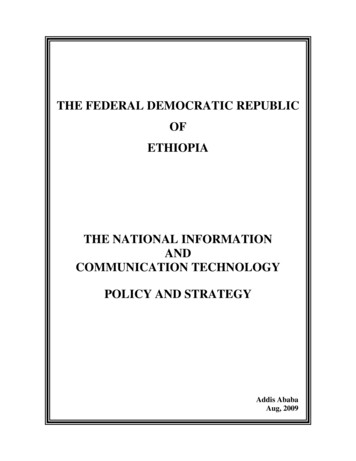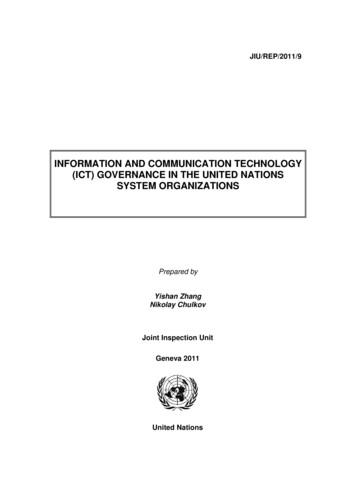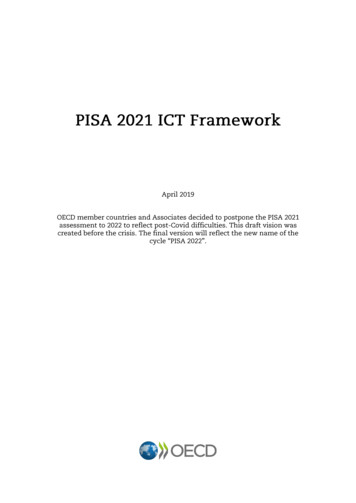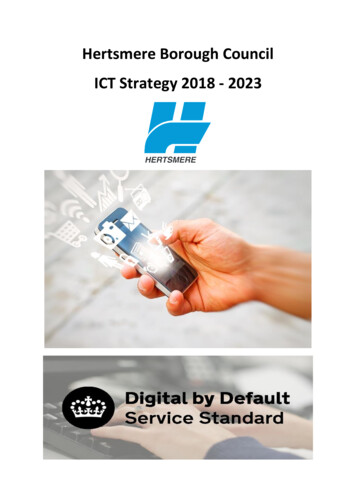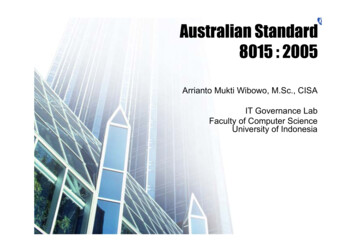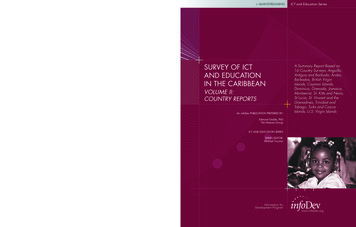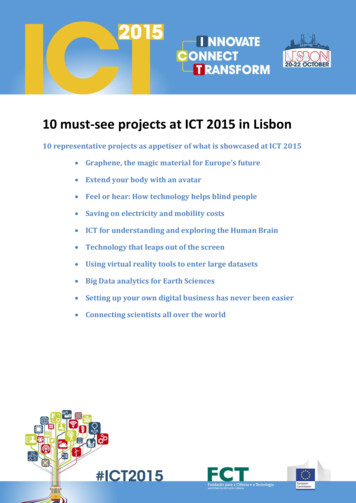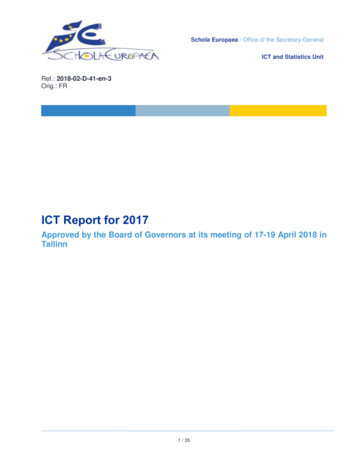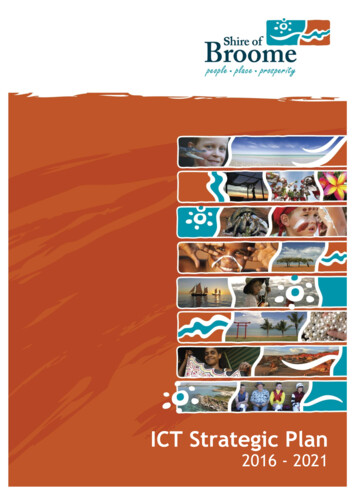
Transcription
ICT Strategic Plan2016 - 2021
ContentsExecutive Summary. 4Integrated Planning and Reporting Framework . 5ICT Strategic Framework . 5ICT Strategic Framework Components . 6Shire of Broome Strategic Community Plan. 7ICT Strategy – Business Alignment . 7Corporate Vision. 7ICT Vision Statement. 7ICT Strategy – Continually Adapting . 8ICT Strategy – Drivers of Change . 8Expectations and ICT Use . 8Governance. 9Emerging Technology . 9Rapid Change and Obsolescence . 9Funding and Staffing. 10Asset Management. 10Location flexibility. 10Environmental Influences . 10ICT Strategy – Guiding Principles . 11ICT Strategic Framework . 11ICT Strategic Theme 1 – Governance . 13Outcome 1.1:Alignment of ICT initiatives with organisational requirements. 13Outcome 1.2:Skilled and capable ICT workforce . 14Outcome 1.3:Maximise benefits through collaborative strategic procurement processes andvendor relationships . 15Outcome 1.4:Optimised internal ICT service provision . 16ICT Strategic Theme 2 – Infrastructure and Technology . 17Outcome 2.1:Lifecycle management of ICT infrastructure . 17Outcome 2.2:Managed infrastructure architecture . 18ICT Strategic Theme 3 – Business Systems & Applications. 20Outcome 3.1:Lifecycle management of business systems and applications . 20Outcome 3.2:Deliver business systems that improve customer satisfaction . 21
ICT Strategic Theme 4 – Emerging Trends and Technologies . 23Outcome 4.1:Utilise cloud services where appropriate to improve service delivery andinnovation . 23Outcome 4.2:Develop online services that optimise the customer service experience . 24Strategy 4.3:Harness developing technology to enable positive organisational andcommunity outcomes . 25ICT Strategic Theme 5 – ICT Business Continuity & Security . 27Outcome 5.1:Develop organisational capabilities surrounding ICT resilience and continuity. 27Outcome 5.2:An operational ICT environment maximising the security and integrity of digitalassets and minimising likelihood and impact of security breaches. . 28ICT Strategic Theme 6 – Information Management. 30Outcome 6.1:Information Management systems are aligned with the strategic andoperational requirements . 30Outcome 6.2:Transition the organisation from information-centred to knowledge-centred. . 31References. 32
Executive SummarySocial, environmental, economic and cultural influences are placing the Shire of Broome in a uniquebut very exciting position. Council and staff are reviewing the collective capability of theorganisation, and its capacity to respond to change effectively whilst not to the detriment ofcommunity expectations.As part of this process the Shire has developed a number of strategic and business plans to ensurethat its services and operations are linked to the overarching strategic direction of Council. The Shireof Broome is dedicated to providing strategic planning, focussed on delivering visionary leadershipand innovation, sound governance and high quality services to the community.Information is a strategic resource that underpins the key functions, decision making processes andservice delivery of local government. The way information is managed, including the technologyused to support it, is therefore central to local government business practices. Alongside its physical,human and financial resources, a local government must manage its information in a way thatenables services to be delivered that best meet community needs and the priorities set by Council.This document describes an Information & Communication Technology (ICT) Strategy for the Shire ofBroome. Although this is an ICT strategy, it is not a technology centric strategy aimed at technicalspecialists. It is a strategy describing how the Shire will align it’s investment in ICT with its businessobjectives, while ensuring community expectations are met. The aim of the Strategy is to driveimproved customer service by delivering ICT services that increase efficiencies while maximisingeffectiveness and minimising costs.The ICT Strategic Plan is focused on pragmatic actions that we can take over the next five years. Itwill undergo a desktop review annually with a full review undertaken biannually.
Integrated Planning and Reporting FrameworkThe Western Australian Government’s Integrated Planning and Reporting (IPR) Framework outlineslocal government planning guidelines through the requirement to develop Strategic CommunityPlans and Corporate Business Plans. The resources needed to implement these plans are identifiedand managed using informing strategy plans.The ICT Strategic Plan is one of the informing strategies forming part of the IPR Framework andprovides a roadmap for ICT operations that will facilitate short, medium and long term communitypriorities and aspirations.Figure 1: Elements of the Integrated Planning FrameworkICT Strategic FrameworkAs part of the IPR Framework the department has developed an ICT Strategic Framework that setsout the key components that need to be considered in managing a local government's informationresources. It represents the key elements, and their relationships, that might be expected in an'ideal' environment (Department of Local Government and Communities, 2013, p 2).The ICT Strategic Framework provides a high level structure for the effective management ofinformation and technology, to ensure ICT systems are controlled and maintained in line withcorporate objectives and emerging trends.
The Shire of Broome ICT Strategic Plan will reflect the recommendations stemming from the DLG’sIPR Framework in relation to ICT Strategy, and will ensure that we meet the baseline requirements.The Shire will endeavour to meet the ideal standard within two years (2018).It should be noted that the ICT Strategic Framework is not a compliance requirement. It is a resourcethat can be used to plan, manage and review information and technology assets.ICT Strategic Framework ComponentsThe ICT Strategic Framework is made up of seven components that are considered to be a minimumbaseline for managing systems, networks, devices and data to ensure that they are secure, protectedappropriately from risk, adequately tested and controlled, and developed in line with corporateobjectives (Department of Local Government and Communities, 2013, p 5):Figure 2: ICT Strategic FrameworkThe ICT Strategic Plan and accompanying ICT Implementation Plan and Long Term ICT Financial Planfall under the Governance component of the framework and will provide direction for all otherelements of the framework.
Shire of Broome Strategic Community PlanFour strategic priorities have been identified in the Shire’s Strategic Community Plan. Each strategicpriority has a set of specific supporting objectives that will be measured to determine whether weare achieving our outcomes.Figure 3: Strategic Community Plan – Strategic PrioritiesThese strategic aspirations form the drivers used to develop and refine ICT strategies, in conjunctionwith ICT technology and trends and best practice, and other external influences. Strategies andactions relevant to the ICT Strategic Plan are primarily contained in the “Our Organisation” theme ofthe Strategic Community Plan.ICT Strategy – Business AlignmentCorporate VisionA thriving and friendly community that recognises our history and embracescultural diversity and economic opportunity, whilst nurturing our unique naturaland built environmentICT Vision StatementTo underpin the delivery of services to the community and assist the Shire of Broome to achieve itsvision an ICT visioning statement has been developed. The vision is built on the principle that theDriving operational excellence and delivering customer satisfaction
most effective role of ICT at the Shire of Broome is to enable the business to achieve operationalexcellence which in turn will drive customer satisfaction.ICT Strategy – Continually AdaptingThe Shire of Broome is affected by a number of internal and external influences which drive theadoption and continual refinement of ICT. The ICT Strategic Plan is an important control tool for theShire, ensuring that influences and changes affecting the direction of ICT at the Shire are capturedand managed proactively.As such the ICT Strategy is an organic document, enabling the organisation to move dynamically tomeet new challenges and expectations, while ensuring an inherent link to the Shire’s strategicobjectives.The ICT Strategy also ensures that ICT objectives and actions are prioritised, allowing theorganisation to more accurately predict future investment in ICT over the next 5 years. Oncecaptured, these investments will be used to populate the Shire’s ICT Asset Management Plan andLong Term Financial Plan.To ensure that the ICT Strategic Plan maintains alignment with the Shire’s Strategic Community Planannual reviews will be conducted. These reviews will be undertaken in conjunction with any plannedreviews of the Strategic Community Plan and Corporate Business Plan as required.ICT Strategy – Drivers of ChangeThe Shire of Broome is currently experiencing rapid changes due to various internal and externalfactors. The most prominent drivers of this change are:Expectations and ICT UseTechnology has changed the way people communicate and access services; as a result people expectgovernment services to be accessible and easy to use. This applies not only to external stakeholdersbut to staff who have an expectation that the technologies they use at home are available at theirworkplace.Strategies need to be developed and implemented to ensure that where a clear benefit can bedetermined, services are delivered quickly. This delivery needs to be carefully balanced from a riskmanagement perspective.In 2012 - 2013, accessing government services or information was among the four most popularonline activities for Australians.In 2012 - 2013 over 83% of Australian households had access to the Internet and over 85% ofAustralians accessed the Internet via a mobile wireless device. It is expected that by 2016 mobiledata traffic will exceed fixed data traffic by three times (Nielsen, 2013).
Figure 5: Key ICT TrendsGovernanceLocal governments are required to adhere to stringent regulatory and legislative requirements.These requirements impact all aspects of operations and must be incorporated into the Shire’sStrategic Community Plan, Corporate Business Plan and informing documents including the ICTStrategic Plan.In addition the Department of Local Government has recently developed an ICT Strategic Frameworkthat local governments must comply with as part of the overarching IPR Framework. Thedevelopment of ICT at the Shire will need to meet the requirements of this framework.Emerging TechnologyThe continual progression of information technology dictates that emerging technology willsignificantly impact the Shire and remain a major influence on strategic direction. Underlying ICTinfrastructure is being enhanced at a rapid pace and this present’s opportunities for the organisationto improve and enhance ICT service delivery.The future direction of ICT development can be predicted to a degree over the next three to fiveyears; however it is very difficult to envisage what form these emerging technologies will take in thelonger term.Rapid Change and ObsolescenceCountering the swift development of emergingtechnology is the rapid obsolescence of ICT products.Software requirements drive the need for improvedhardware and shortened equipment life is linked todecreased return on investment.The current equipment replacement scheduledictates that a third of equipment is replaced afterthree years, however industry indicators suggest thatthis figure may drop to keep pace with ICT hardwaredevelopment.
Funding and StaffingEnsuring adequate funding for ICT is a focus of the ICT Strategic Plan. Outcomes derived from theplan will be included in the Shire’s ICT Asset Plan and Long Term Financial Plan to ensure a viable,ongoing funding stream.Attracting and retaining skilled ICT staff is also a core driver of the ICT Strategic Plan. The attractionand retention of appropriately experienced and qualified staff is vital to ensure the successfuldelivery of ICT strategies and objectives. In addition the plan will ensure that alternate optionsincluding cloud hosted services and outsourcing are explored.Asset ManagementManagement and control of ICT assets is vital to ongoing operations and needs to be aligned withthe Shire’s overarching Asset Management Plan to guarantee appropriate management of assets.Location flexibilityLocal government services are continually morphing to meet community needs. These changesnecessitate transformation of traditional delivery channels to ensure staff are equipped toeffectively and efficiently deliver services. ICT will be required to enhance systems to ensure reliable,secure and transparent access to Shire resources from anywhere, at any time.Environmental InfluencesThese drivers include the growth of the Shireof Broome and specific major projects thatwill have a significant influence on theoperations of the Shire. Some of theseprojects have been approved forcommencement; some have commenced andsome are still in the concept stage. Yawuru Native Title;Regional Growth Centre initiative;Local government services inindigenous communities;National Broadband Network; andProposed mining, oil and gasdevelopments.
ICT Strategy – Guiding PrinciplesThe following key principles will assist Information Services (IS) to achieve the vision and define the'culture of ICT' at the Shire:Strategic AlignmentICT strategic decisions will be driven by and aligned with businessstrategies and requirements.Engage with the BusinessIS will engage early with the business to ensure that ICT requirementsfor business initiatives are captured, clearly defined and adequatelybudgeted.ICT InfrastructureThe ICT infrastructure will be simple, well architected, integrated,reliable and secure.Service ExcellenceICT will deliver timely, reliable and consistent support service to thebusiness.Information as an AssetInformation will be valued as an asset and will be available andmanaged to support service delivery, better decision making andinnovation.Business SystemsWe will aim to maximise investment in existing solutions beforeconsidering new solutions. Applications will have significant marketshare and provide flexible support and licensing options.Innovate and CollaborateICT solutions will be innovative, easy to use and supportcollaboration.Centralise ICT DecisionsMajor ICT decisions will be made centrally by IS in consultation withthe business through a formal ICT governance process.Continually ImproveMetrics and customer feedback will be utilised to measureperformance and improve efficiencies.Leverage VendorManagementWhere possible IS will leverage vendor and procurementmanagement to ensure maximum tactical and strategic value fromsuppliers.ICT Strategic FrameworkThe Department of Local Government and Communities Information Technology Framework will beutilised as a baseline to develop the Shire of Broome ICT Strategic Plan themes.The IT Framework represents the discipline of IT management as comprising seven key elements.The framework has been designed with four pillars reflecting the four main IT disciplines, withoverarching governance and robust project management underpinning the framework. Thepositioning of Emerging Technologies and Trends over the four pillars of IT recognises the role thatdisruptive technologies has on the delivery of IT services.
The key elements of the IT Framework are:GovernanceStrategies, principles and practices that guide the correct and effectivedelivery of ICT, and provides a framework for ICT decision makingEmerging Trends and TechnologiesProviding challenges and opportunities for local government inmanaging ICT systems and resources, and delivery of future ICTservicesBusiness Systems and ApplicationsSoftware systems and applications used by a local governmentInfrastructure and TechnologyHardware and network infrastructure used to deliver localgovernment ICT servicesIT Business ContinuityActivities undertaken to enable a local government to perform its keyfunctions and deliver its ICT servicesSecurityProtecting information and systems from unauthorised access, use,modification, disclosure or destructionProject ManagementPlanning, organising, controlling, and managing resources to achievespecific goalsThe key elements comprise a number of lower level elements. Together, these elements describethe discipline of managing each of the key elements identified within the framework.
Action Legend:Planning:Delivery:Business As Usual:ICT Strategic Theme 1 – GovernanceThe current and future use of ICT at the Shire of Broome will be directed and controlled by a formalised governance framework that will ensure ICT decisionsare made in alignment with strategic business priorities. The development of a governance framework ensures a comprehensive understanding of the valueand impact of ICT investments allowing enhanced service delivery to staff and stakeholders.Improved governance processes will assist in identifying opportunities for ICT use across the organisation, making decisions visible and transparent,minimising risk, increasing benefit realisation and encouraging compliance with policies and standards.Outcome 1.1: Alignment of ICT initiatives with organisational requirementsStrategy 1.1.1Develop and implement ICT governance framework.Strategy 1.1.2Improved ICT Strategic Plan review and performance reporting process in line with relevant industry standards.IndicativeBudgetElapsedTimeInstitute a COBIT based ICT Governance Framework: ICT Steering Committee; ICT Organisational Structure; and ICT Accountability & Reporting Process.Internal4 monthsDevelop ICT Strategic Framework: ICT Strategic Plan; ICT Business Plan; ICT Asset Management Plan; ICT Long Term Financial Plan; ICT Risk Management Plan; Supporting documents; andInternalOngoingActions1.1.1-11.1.2-1Timeframe / Resources16/1717/1818/1919/2020/21
Annual review process.1.1.2-2Develop next iteration of ICT Strategic Plan. 45K3 months 35K3 months1.1.2-3Develop Digital Strategy.1.1.2-4Develop GIS Strategy.Internal2 months1.1.2-5Ensure annual ICT budget process reflects financial modellingcontained in the Shire’s ICT Asset Management Plan and LongTerm ICT Financial Plan.InternalOngoing45K 4 54K5KOutcome 1.2: Skilled and capable ICT workforceStrategy 1.2.1ICT key competencies are captured in workforce plan.Strategy 1.2.2Managed, shared and outsourced ICT service delivery models are fully exploited where appropriate.Strategy 1.2.3Ensure suitable staff training and professional development systems in rify and standardise ICT position descriptions and undertakeskills assessment.Internal2 weeks1.2.1-2Develop ICT key personnel requirements and ensure theseneeds are captured in relevant workforce planning documents.Internal2 weeks1.2.2-1Assess relevant ICT service deliver methods and migrate to “as aservice” where appropriate business benefits can be delivered.Unknown2 months1.2.2-1Investigate suitability of outsourced management of Shire ICTassets – local and remote.Internal2 monthsTimeframe / Resources16/1717/1818/1919/2020/21
1.2.3-1Support ICT staff to adapt to changing technologies.1.2.3-2Develop and implement strategy to address ICT skills shortages. 14KOngoingInternalOngoingOutcome 1.3: Maximise benefits through collaborative strategic procurement processes and vendor relationshipsStrategy 1.3.1Develop and refine best practice, adaptive ICT procurement policies and frameworks.Strategy 1.3.2Ensure local and government provided procurement arrangements are fully exploited.Strategy 1.3.3Ensure maximum organisational value is achieved though effective contract 1Develop and review adaptive ICT procurement framework,policy, process and procedures.Internal2 months1.3.1-2Establish processes to enable the identification of departmentalcosts and service levels.Internal1 month1.3.2-1Investigate government provided ICT contractual arrangements.InternalOngoing1.3.2-2Develop and implement purchasing arrangements with localproviders where cost effective mutual benefits can bedemonstrated.Internal1 month1.3.3-1Implement annual ICT software and hardware contract reviewprocess.Internal1 month1.3.3-2Exploit telecommunication service contracts to ensureoperational and financial benefits are maximised.InternalOngoingTimeframe / Resources16/1717/1818/1919/2020/21
1.3.3-3Engage Microsoft Licensing Specialist to audit current statesoftware use.ContractProvision12 months1Benefit stemming from WALGA Microsoft Licensing AgreementOutcome 1.4: Optimised internal ICT service provisionStrategy 1.4.1Adopt standards based, adaptive internal ICT service management framework to optimise ICT operations.Strategy 1.4.2Ensure efficient and effective use of ICT alOngoing 10K6 months1.4.1-1Develop ICT policy, process and procedure analysis and reviewframework.1.4.1-2Implement ITIL based ICT business process optimisation /service management systems.1.4.1-3Implement ICT maturity assessment and improvement plan.Internal3 months1.4.2-1Develop ICT performance reporting framework and tools toensure ICT transparency, compliance and control.Internal2 months1.4.2-2Implement ongoing review and development of internal servicelevel agreement.InternalOngoing1.4.2-3Implement standards based ICT project managementmethodology Project funding and management methodology Project portfolio website. 33K2 months**Note no organisational training costs includedTimeframe / Resources16/1717/1818/1919/2020/21
Action Legend:Planning:Delivery:Business As Usual:ICT Strategic Theme 2 – Infrastructure and TechnologyICT infrastructure and technology underpins the effective delivery of customer service by the organisation. As such ICT infrastructure and technology must beeffectively managed to ensure organisational deliverables are achieved. A formalised approach to ongoing management and innovation must be developedand adequately financed to realise this outcome. This action must account for all aspects of ICT infrastructure and must derive support from all levels of theorganisation and Council.Telecommunications are also an integral aspect of the ongoing operations of the Shire. Strategic direction is required to ensure that telecommunicationservices offered to the community are appropriate, particularly with the impending implementation of NBN in the region.Outcome 2.1: Lifecycle management of ICT infrastructureStrategy 2.1.1Ensure organisational support and funding for ICT infrastructure.Strategy 2.1.2Minimise the environmental impact of ICT -1Integrate lifecycle management of ICT infrastructure into LongTerm Financial Plan and ICT Asset Management Plan.Internal1 week2.1.1-2Investigate alternate funding and cost sharing opportunities forICT.InternalOngoing2.1.2-1Develop ICT Sustainability Strategy to identify and rationalisethe environmental impact of ICT operations. Reduce print impacts Consolidate equipment to reduce energy consumption Reduce paper use and waste Ongoing analysis of energy consumptionInternal2 monthsTimeframe / Resources16/1717/1818/1919/2020/21
Asset disposal.Outcome 2.2: Managed infrastructure architectureStrategy 2.2.1A simple well architected ICT infrastructure that acts as an enabler for business systems.Strategy 2.2.2Implement standards based infrastructure architecture frameworks.Strategy 2.2.3Telecommunications services are robust, scalable and meet organisational and community needs.ActionsIndicativeBudgetElapsedTimeInternal2 months2.2.1-1Develop ICT Infrastructure Roadmap and Transition Plan withongoing annual reviews.2.2.1-2Undertake Hyper-V suitability and transition assessment. 10K2 months2.2.1-3Implement Citrix to enhance terminal server performance. 20K1 month2.2.1-4Undertake Civic Centre audio visual upgrades 50K3 months2.2.1-5Upgrade Administration Office ICT cabling and infrastructure 60K2 months2.2.1-6Implement public wireless in the Civic Centre 10K1 month2.2.1-7Replace Civic Centre building management system (lighting,security, fire) 50K2 months2.2.2-1Develop and implement TOGAF Architecture Reference Modeland Framework.Internal2 months2.2.2-2Ensure desktop computer standard operating environment(SOE) meets organisational requirements.Internal2 weeksTimeframe / Resources16/1717/1818/1919/2020/21
2.2.3-1Regularly review the applicability of availabletelecommunication technologies.InternalOngoing2.2.3-2Implement Unified Communication System. 50K3 months2.2.3-3Implement hardware based video conference facilities. 20K1 month2.2.3-4Implement direct fibre connection to Telstra exchange. 100K
Action Legend:Planning:Delivery:Business As Usual:ICT Strategic Theme 3 – Business Systems & ApplicationsThe strategic management and delivery of business systems and applications across the organisation is essential in delivering quality customer serviceoutcomes. These systems need to be efficient and effective for the organisation while ensuring consumer needs are serviced appropriately. As such theoverarching aim of this strategic theme is to align business systems and applications with the functional requirements of the business and the useabilityrequirements of our users.In line with the ICT principle to maximise investment in existing solutions, work will continue to develop SynergySoft so it delivers maximum effectiveness forthe business. This will involve developing capabilities around integration, automation, online services and reporting. Best of breed software utilised forspecific business unit requirements will be tailored to ensure integration with core SynergySoft modules and other business systems where relevant.Outcome 3.1: Lifecycle management of business systems and applicationsStrategy 3.1.1Ensure business systems and applications are aligned with strategic direction to ensure sustainability.Strategy 3.1.2Ensure ongoing business system and application costs are rationalised and sustainable.IndicativeBudgetElapsedTimeIntegrate lifecycle management of business systems andapplications into Long Term Financial Plan and ICT AssetManagement Plan.Internal2 weeks3.1.1-2Develop business system roadmap for core systems.Internal1 month3.1.2-1Develop adaptive business system and application managementframework.Inte
It should be noted that the ICT Strategic Framework is not a compliance requirement. It is a resource that can be used to plan, manage and review information and technology assets. ICT Strategic Framework Components The ICT Strategic Framework is made up of seven components that are considered to be a minimum
